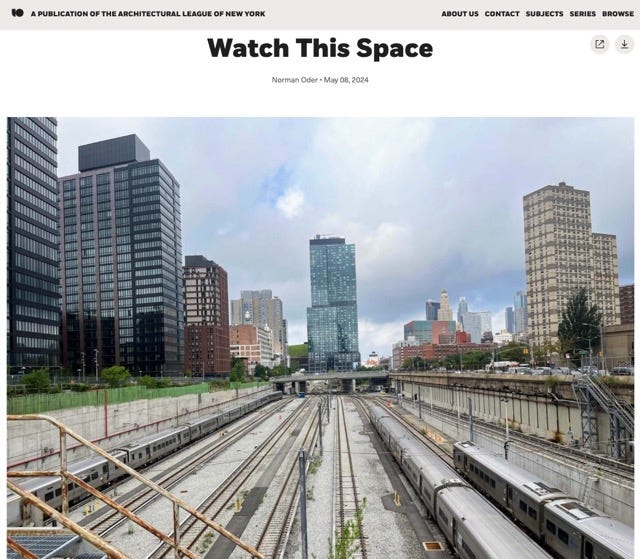Weekly Digest #21: An Atlantic Yards Look Back and a New Controversy
The Pacific Park Conservancy's a phantom, which makes it tough to address a noisy dog run.
This digest offers a way for people to keep up with my Atlantic Yards/Pacific Park Report blog, as well as my other coverage in this newsletter and elsewhere.
Atlantic Yards/Pacific Park is so complicated that, despite creating a long FAQ and working on a (much longer) book manuscript—completion TBD—I’ve never written a concise history of the project.
Well, thanks to Urban Omnibus, a publication of the Architectural League of New York, for commissioning what became Watch This Space—or, in my working title, “Whatever Happened to Atlantic Yards?”
The answer is: a lot—and with much unsaid. So it’s a good way to get a grasp on the project’s past and future, even as many of the episodes merit further exposition.

Much of the article may not be new to the most committed Atlantic Yards watchers, though it’s hard to remember it all! Soon I’ll separately highlight what I consider one of the most important elements, which was new.
New controversy
It’s worth remembering that Atlantic Yards/Pacific Park is an ongoing story, not merely a settled history.
So, as I was working on the Urban Omnibus article, I was keeping my eye on other issues, including an emerging controversy regarding the new dog run in the segment of the “Pacific Park” open space between 535 Carlton and the West Tower of 595 Dean.
It turns out, as I reported, that some of the 595 Dean residents are disturbed by persistent barking. Also, it wasn’t the original location for a dog run, so it might not have been the wisest choice, at least not without further sound-dampening vegetation and/or barriers.
What adds to the confusion, and frustration, is that the 595 Dean developer, TF Cornerstone, deflected complaints to the Pacific Park Conservancy, a nonprofit set up to manage the open space.
But the Conservancy’s a phantom, with its announced phone number and email address nonfunctional. Moreover, none of the three directors I contacted responded to my queries, and there may not be any directors representing the public.
Also, in its first two years of operation, the Conservancy spent far more on insurance and legal fees than in maintaining the open space. Maybe that represents legitimate start-up costs, but there’s nobody (yet) willing to explain it.
From Substack
May 6: Flashback, 2012: Atlantic Yards Flack Claims Retail Changes Equal Railyard Revamp
Original developer Bruce Ratner’s blasé attitude toward not finishing Atlantic Yards reminded me of an April 17, 2012 New York Times article focusing on retail changes near the arena, which suggested—apparently paraphrasing the developer’s spokesman—that the “scar” of the open railyard had been healed.
And that reminded me of how The Brooklyn Paper, once a more critical publication, reported Mayor Mike Bloomberg’s endorsement of Ratner’s trustworthiness under the headline In Bruce We Trust.
When Ratner was asked about the enforceability of the Community Benefits Agreement, which had no governmental signatories, he claimed it was “legally binding,” with economic penalties, mediation, and the possibility of litigation.
Bloomberg interjected: “I would add something else — even more importantly, you have Bruce Ratner’s word. That should be enough for you and for everybody else in the community.”
Maybe not so much.
From: Atlantic Yards/Pacific Park Report
May 7: At 595 Dean, West Tower residents lament noise from adjacent dog run. Developer TF Cornerstone deflects to (phantom) Pacific Park Conservancy.
May 8: While the Pacific Park Conservancy is supposed to maintain project open space, it's spent far more on insurance and lawyers.
May 11: The Real Deal: "Embellishing the truth is second nature to many real estate developers."
May 12: As developer Ratner continues media interviews and establishes Early Detection (Cancer) Initiative, his career misleadingly framed as steady "progressive" path. What about the Community Benefits Agreement he abandoned?





